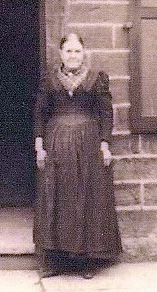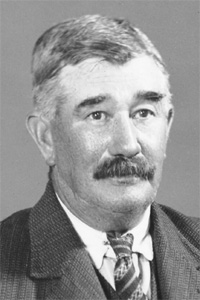Mary Ann Lees
ID# 31, b. 22 April 1832, d. 29 December 1904

Worked as a barmaid at The Royal Oak Public House.
Daughter (Maria) used to serve ale from an old barge ware jug with the inscription " Mary Ann Chadwick Rochdale 1883"
- source Eunice Diamond (née Kershaw) Jug now in her possession.
***************
Mary Ann was christened on 15 July 1832 at Mottram-In-Longendale, Cheshire. This was at St. Michael & All Angels church.
In 1844, the working hours of children age eight to thirteen was reduced to 6 1/2 hours a day.
Mary Ann married William and raised the family.
In 1871 they lived at 71 Well-in-the-Lane (Well i'th'Lane), Rochdale.
After William died she married a John Chadwick and lived at 99 Lower Place, Castleton in 1881. John was a Beer Seller. By 1891 Mary was widowed again and her three youngest children lived with her at 99 Platting Lane - (Royal Oak) , (1891 census).
She was a beer house keeper. This beer house is the same as the Royal Oak Pub later run by Albert and Ada. In 1891 Albert's residence, formerly 93 Lower Place, was now called 93 Platting Lane
***************.
Daughter (Maria) used to serve ale from an old barge ware jug with the inscription " Mary Ann Chadwick Rochdale 1883"
- source Eunice Diamond (née Kershaw) Jug now in her possession.
***************
Mary Ann was christened on 15 July 1832 at Mottram-In-Longendale, Cheshire. This was at St. Michael & All Angels church.
In 1844, the working hours of children age eight to thirteen was reduced to 6 1/2 hours a day.
Mary Ann married William and raised the family.
In 1871 they lived at 71 Well-in-the-Lane (Well i'th'Lane), Rochdale.
After William died she married a John Chadwick and lived at 99 Lower Place, Castleton in 1881. John was a Beer Seller. By 1891 Mary was widowed again and her three youngest children lived with her at 99 Platting Lane - (Royal Oak) , (1891 census).
She was a beer house keeper. This beer house is the same as the Royal Oak Pub later run by Albert and Ada. In 1891 Albert's residence, formerly 93 Lower Place, was now called 93 Platting Lane
***************.

Birth:
Mary Ann Lees was born on 22 April 1832 at Micklehurst, Ashton-under-Lyne R.D., Lancashire, England,
Mary Ann is recorded as age 22 at her 1850 marriage. This would give her birth year as 1828.
I have not found an 1828 birth with father James, so am going with the 1832 one (which fits better with later census ages).
There is a Mary Ann Lees baptized 3 Apr 1828 - a daughter of William & Mary of Broadbottom (Mottram-in-Longdendale Parish)
A separate Mottram-in-Longdendale copy shows a Mary Ann Lees baptized 27 Apr 1828 - a daughter of William & Mary of Mottram.
I have not found an 1828 birth with father James, so am going with the 1832 one (which fits better with later census ages).
There is a Mary Ann Lees baptized 3 Apr 1828 - a daughter of William & Mary of Broadbottom (Mottram-in-Longdendale Parish)
A separate Mottram-in-Longdendale copy shows a Mary Ann Lees baptized 27 Apr 1828 - a daughter of William & Mary of Mottram.
Mary Ann Lees was the daughter of James Lees and Martha (?)

Mary Ann Lees was baptised on 15 July 1832 at Mottram in Longdendale Parish, Cheshire, England,
'No.2385; Mary Ann [daughter of] James & Martha Lees; abode: Micklehurst; occupation: Clothier'
Mottram-in-Longdendale Parish baptisms 1832 p.299.
Mottram-in-Longdendale Parish baptisms 1832 p.299.

in 1850 at Micklehurst, Tintwistle, Cheshire, England, Mary Ann Lees was a Frame Tenter.

Marriage:
Mary Ann Lees married William Dearnaley, son of Amos Dearnaley and Ann Hurst, on 22 September 1850 at Christ Church, Tintwistle, Cheshire, England,
William Dearnaley 21 Bachelor, Woollen Slubber res: Micklehurst fa: Amos Dearnley, Woollen Weaver
Mary Ann Lees 22 Spinster, Frame Tenter res: Micklehurst fa: James Lees, Farmer
Both made their mark
Witnesses: Henry Boyer & [Henry?] Sherriff*
* looks a little like 'Harvy/Harry Sherriff'.
Speculation: Mary Ann may have added a few years to her age in order to be "over 21". At this time, marriage below 21 is thought to have needed the consent of parents or guardian*. If both parents had died, this might be quite complicated.
* Parental consent - this was briefly required between 1753 & 1823. Before and after this period, consent should be obtained but the marriage was neither void nor voidable if no consent had been obtained. - unsourced Web forum.

in October 1863 Mary Ann Lees lived at Kershaw Place, Rochdale Parish, Lancashire, England,
.

Marriage:
Mary Ann Lees married John Chadwick about November 1875 at St. Mary's Church, Balderstone, Rochdale, Lancashire, England,
.

Death:
Mary Ann Lees died on 29 December 1904 at Castleton, Rochdale, Lancashire, England, at age 72 years, 8 months and 7 days
Indexed as Mary Ann Chadwick, aged 72.
Children of Mary Ann Lees and William Dearnaley
- James Lees Dearnley+ b. 14 Feb 1851, d. 1 Sep 1899
- Abel Dearnaley+ b. 21 Jul 1854, d. 5 Sep 1898
- Herbert Dearnley+ b. 3 Mar 1857, d. 18 Feb 1906
- Albert Dearnley+ b. 11 Sep 1859, d. 5 Dec 1917
- Alice Ann Dearnley+ b. 7 Jul 1862, d. abt Feb 1935
- Hannah Maria Dearnley b. 26 Mar 1864, d. Nov 1866
- Martha Ann Dearnley+ b. 5 Feb 1866, d. 13 Dec 1941
- Maria Dearnley+ b. 13 Jan 1869, d. abt Aug 1954
- Amos Dearnley+ b. 1 Jan 1871, d. 12 Sep 1899
- William Dearnley+ b. 5 May 1873, d. 23 Dec 1958
Abraham Whiteley
ID# 32, b. December 1814, d. February 1875
- Charts
- Peter Whiteley (c.1778-)

Birth:
Abraham Whiteley was born in December 1814 at Sowerby, Yorkshire, England,
Birth date is an estimate.
Sowerby's name comes from the Viking (Norse) language, in which it means "Farmstead (by the) smelly pit", or "a homestead with poor soil" - depending on which web entry you trust!
Apparently, the origin of the word sewer.
Sowerby's name comes from the Viking (Norse) language, in which it means "Farmstead (by the) smelly pit", or "a homestead with poor soil" - depending on which web entry you trust!
Apparently, the origin of the word sewer.
Abraham Whiteley was the son of Peter Whiteley and Susey Hansen.

Abraham Whiteley was baptised on 8 January 1815 at Sowerby Green Old Chapel Independant, Sowerby, Yorkshire, England,
Father's Name: Peter Whiteley
Mother's Name: Susey
(FamilySearch - transcript only.)
Mother's Name: Susey
(FamilySearch - transcript only.)

Marriage:
Abraham Whiteley married Hannah Haworth, daughter of Henry Haworth, on 22 October 1848 at St. Mary's Church, Bury, Lancashire, England,
Abraham Whiteley of Full Age Bachelor, Twister res: Halifax fa: Peter Whiteley, Weaver
Hannah Haworth of Full Age Spinster, --- res: Heap fa: Henry Haworth, Twister
Both made their mark
Witnesses: John Crossley & Ka(?) Crompton.

Death:
Abraham Whiteley died in February 1875 at Castleton, Rochdale R.D., Lancashire, England, at age 60 years and 2 months
recorded as age 60.

Abraham Whiteley was buried on 28 February 1875 at St John in the Wilderness, Cragg Vale, Yorkshire, England,
'No.262; Abraham Whiteley; abode Rochdale; aged 60 years'
Burials in the Parish of Halifax, District Chapelry of St John 1875. p.33.
Burials in the Parish of Halifax, District Chapelry of St John 1875. p.33.
Children of Abraham Whiteley and Hannah Haworth
- Henry Whiteley+ b. 24 Dec 1849
- Mary Ellen Whiteley+ b. 10 Oct 1851
- Susey Hannah Whiteley b. 3 Jul 1853, d. abt Aug 1871
- Deborah Whiteley+ b. 12 Jan 1856
- Leonard Whiteley+ b. abt Sep 1858, d. abt Nov 1899
- Ada Whiteley+ b. 27 Oct 1861, d. 17 Aug 1942
William Pack
ID# 33, b. 30 August 1840, d. about November 1917
- Charts
- Samuel Pack (c.1749-)

Birth:
William Pack was born on 30 August 1840 at Millbrook, Hampshire, England,
.
William Pack was the son of William Pack and Sarah Glasspool.

William Pack was baptised on 27 September 1840 at Millbrook, Hampshire, England,
.

William Pack began military service on 4 May 1859
The Naval Career of William Pack
At age 19, on 4 May 1859 he volunteered for ten years of service in the Royal Navy. William Pack stood 5' 4 ¾" had light brown hair and blue eyes with fair complexion. Upon enlisting he was assigned to the HMS Britannia as Boy 1st Class. The HMS Britannia (the 3rd by that name) was a 120-gun first-rate ship-of-the-line of the Royal Navy, laid down in 1813 and launched on 20 October 1820. She was commissioned in 1823, and saw service in the Mediterranean from 1830-31 and in 1841. She was decommissioned in 1843, before returning to service for the Crimean War, serving as flagship of Admiral Sir James Deans Dundas, commanding the British fleet in the Mediterranean and Black Sea from 1851-54. The HMS Britannia returned to England at the beginning of 1855 and that year became a hospital ship at Portsmouth, then a cadet training ship in 1859 under the command of Captain Robert Harris. It was to this training ship that William Pack was assigned. HRH Prince George (future King George V), became a cadet on this same ship in September 1877. William was promoted in rank to ordinary Seaman 2nd Class on 4 Sept 1859 and he was noted as having very good character. He was discharged from the HMS Britannia on 20 Feb 1860 an assigned to the HMS Royal Albert the following day.
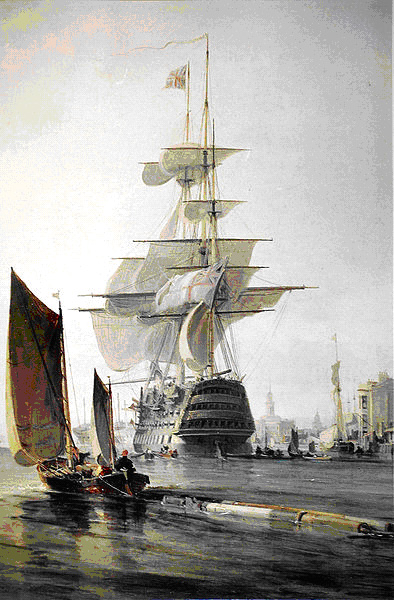
HMS Britannia
The HMS Royal Albert was a 121 gun three-decker ship launched at Woolwich Dockyard in 1854. Originally designed as a sailing ship, she was converted to screw propulsion while still under construction. From commissioning at Sheerness she was first commanded by Commander Alexander Little between June and October 1854. From October to November 1854 by Captain Thomas Sabine Pasley while still at Sheerness. From 14 February 1855 to April 1857 she was commanded by Captain William Robert Mends as flagship to Rear-Admiral Edmund Lyons commanding the Mediterranean fleet, then chiefly concerned with the Crimean War. From April 1857 to 20 August 1858 she was commanded by Captain Francis Egerton. From 25 August 1858 to October 1859 she was commanded by Captain Edward Bridges Rice as part of the Channel Squadron under Rear-Admiral Charles Howe Fremantle. The HMS Royal Albert received a new captain on 1 October 1859, Captain Henry James Lacon, who remained up to her paying off at Plymouth on 25 January 1861. William Pack first served under Captain Rice 4-30 Sept 1859 and then from 1 Oct 1859 to 25 Jan 1861 under Captain Lacon. On 24 Feb 1860 they set sail for Lisbon, Portugal. On 10 July 1860, the HMS Royal Albert, flagship of the Channel Squadron, was reviewed at sea by HRH Albert Edward, Prince of Wales, before his departure for Canada. On 1 Aug 1860 William Pack was promoted from Ordinary Seaman 2nd Class to Full Ordinary Class for his "very good" character. The HMS Royal Albert had a complement of 1,050 men.
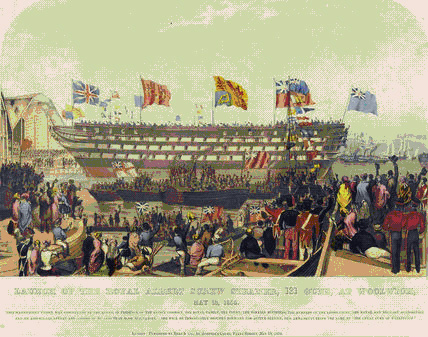
HMS Royal Albert
On 26 Jan 1861, William Pack was assigned to the HMS Narcissus (the 3rd bearing that name). She was wooden-hulled screw-frigate in service from 1859 to 1883. Constructed in Devonport, she launched 26 Oct 1859. She was under the command of Captain Richard Hawkins Risk as the flagship of Rear-Admiral Baldwin Wake Walker sailing to the Cape of Good Hope. From 27 Jan 1862 until 6 Aug 1864 she was under the command of Captain Joseph Grant Bickford around the Cape of Good Hope and in the East Indies. William Pack was promoted from Seaman Ordinary Class to Able Seaman on 1 Feb 1864. He served on the HMS Narcissus until 6 Aug 1864 when he was assigned to the HMS Victoria.
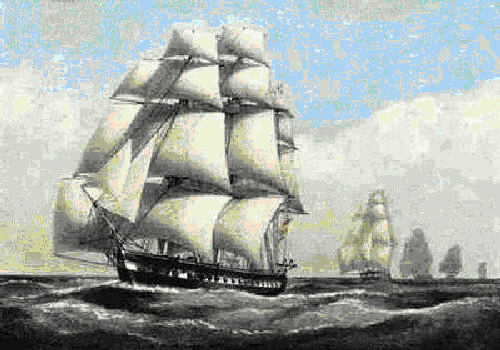
HMS Narcissus
HMS Victoria was the last British wooden first-rate three-decked ship of the line commissioned for sea service. With a displacement of 6,959 tons, she was the largest wooden battleship which ever entered service. She was also the world's largest warship until the completion of HMS Warrior, Britain's first ironclad battleship, in 1861. Victoria´s hull was 79.2 metres (260 ft) long and 18.3 metres (60 ft) wide. She had a medium draught of 8.4 metres (27.5 ft). Her hull was heavily strapped with diagonal iron riders for extra stability. Victoria was the first British battleship with two funnels.
She was armed with a total of 121 guns (32 8-inch (200 mm) guns on the lower gun deck, 30 8-inch (200 mm) guns on the central gun deck, 32 32-pounders on the upper gun deck, 26 32-pounders and one 68-pounder on the upper deck). Victoria was ordered on 6 January 1855, laid down on 1 April 1856 at Portsmouth, and launched on 12 November 1859. She cost a total of £150,578 (2010: £11,401,000) and had a complement of 1,000.
During trials in Stokes Bay on 5 July 1860 HMS Victoria reached a top speed of 11.797 knots (21.848 km/h), making her the fastest three decker worldwide. Her Maudslay engine was powered by 8 boilers and developed 4,403 ihp. After completion Victoria was laid up as part of the reserve fleet at Portsmouth from 1860 to 1864. Able Seaman Pack was assigned to the HMS Victoria on 7 Aug 1864 and served her until 7 Aug 1867. Once again his service was noted as "very good." He received his first badge on 7 Aug 1866 and his second on 7 Aug 1868. The HMS Victora first entered active service on 2 November 1864, when she became the Flagship of the Mediterranean fleet under Vice-Admiral Smart and Captain Goodenough, and from 1865: Rear-Admiral Lord Clarence Paget, Captain Gardner. HMS Victoria was based in Malta until 1867 when she returned home. Her armament had been reduced to 102 guns. Her last public appearance came at the 17 July 1867 Spithead Review before Her Majesty Queen Victoria. The HMS Victoria was paid off on 7 August 1867.
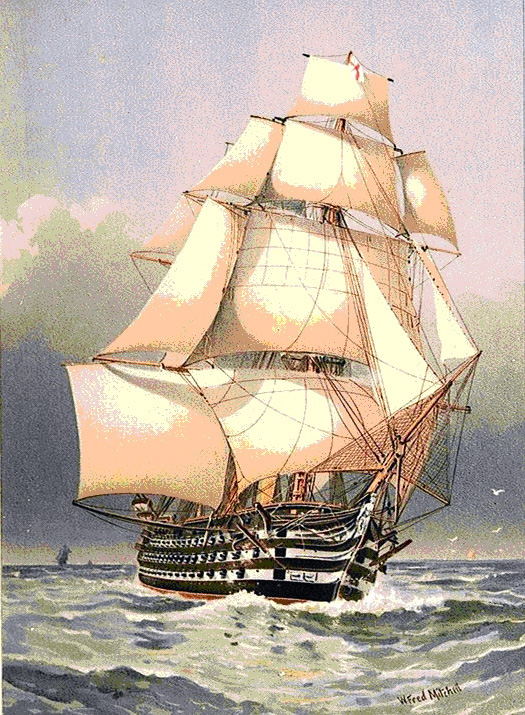
HMS Victoria, 121 Guns
On 8 Aug 1867, Able Seaman William Pack married Mary Jane Bound at Bishop's Waltham, Hampshire. The gap between the date of his marriage and the birth of his first children in August 1871 is explained by his Navy service.
That same day, 8 Aug 1867, Able Seaman Pack was assigned to the HMS Boscawen under the command of Commander McLeod Baynes Cockcraft until 11 Oct 1867 and then under the command of Commander Henry Fairfax. Seaman Pack served on board until 15 Oct 1869. HMS Boscawen (the 3rd by that name) was a 70-gun third rate ship of the line of the Royal Navy, launched on 3 April 1844 at Woolwich Dockyard. She was originally ordered and begun as a 74-gun ship, but an Admiralty order dated 3 March 1834 required that she be reworked to Sir William Symonds' design. She was named for Admiral Edward Boscawen. The HMS Boscawen served as a training ship since 5 Mar 1862 at Portsmouth. Seaman Pack was now showing the ropes to new recruits.
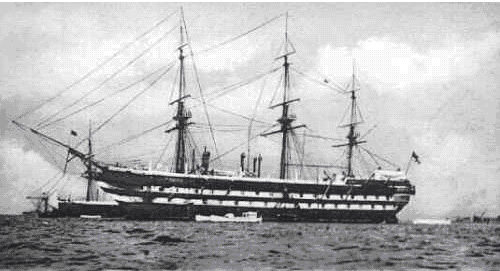
HMS Boscawen
On 16 Apr 1869, when William Pack's ten years duty was coming to an end, he was assigned to the Coast Guard per his request. He served on the HMS Trafalgar under the command of Captain Edward King Barnard. Seaman Pack had enlisted for another ten years of service. HMS Trafalgar was a 120-gun first rate ship of the line of the Royal Navy, launched on 21 June 1841 at Woolwich Dockyard. She was the last to be completed of the successful Caledonia class. The ship was named by Lady Bridport, niece of Lord Nelson at the request of Queen Victoria, who with Prince Albert also attended the launch. The wine used was some kept from HMS Victory after returning from Trafalgar. Five hundred people were on board the ship at the time of its launch, of whom 100 had been at Trafalgar. It was estimated 500,000 people came to watch the event and the Thames was covered for miles with all manner of boats. The launch was the subject of the most notable work by Woolwich-based artist William Ranwell. It played a role in the Crimean War, bombing Sebastopol. The HMS Trafalgar was fitted with screw propulsion in 1859 and was subsequently commissioned for the Coast Guard on 1 Mar 1864.
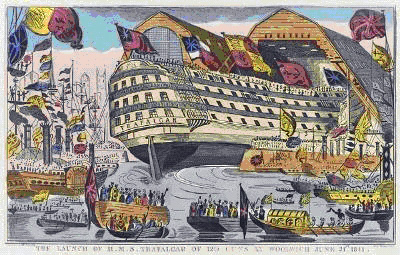
HMS Trafalgar
By 1871 Seaman Pack had retired from the Royal Navy but later worked as H.M. Customs Officer in Southampton at least through 1901. In 1911 he lived at 11 English Rd. in Shirley, Hampshire receiving a Navy pension. He probably is to be identified with the William Pack born abt 1840 whose death was registered Oct-Dec 1917 in Southampton.
Daniel Stramara
.......................................
At age 19, on 4 May 1859 he volunteered for ten years of service in the Royal Navy. William Pack stood 5' 4 ¾" had light brown hair and blue eyes with fair complexion. Upon enlisting he was assigned to the HMS Britannia as Boy 1st Class. The HMS Britannia (the 3rd by that name) was a 120-gun first-rate ship-of-the-line of the Royal Navy, laid down in 1813 and launched on 20 October 1820. She was commissioned in 1823, and saw service in the Mediterranean from 1830-31 and in 1841. She was decommissioned in 1843, before returning to service for the Crimean War, serving as flagship of Admiral Sir James Deans Dundas, commanding the British fleet in the Mediterranean and Black Sea from 1851-54. The HMS Britannia returned to England at the beginning of 1855 and that year became a hospital ship at Portsmouth, then a cadet training ship in 1859 under the command of Captain Robert Harris. It was to this training ship that William Pack was assigned. HRH Prince George (future King George V), became a cadet on this same ship in September 1877. William was promoted in rank to ordinary Seaman 2nd Class on 4 Sept 1859 and he was noted as having very good character. He was discharged from the HMS Britannia on 20 Feb 1860 an assigned to the HMS Royal Albert the following day.

The HMS Royal Albert was a 121 gun three-decker ship launched at Woolwich Dockyard in 1854. Originally designed as a sailing ship, she was converted to screw propulsion while still under construction. From commissioning at Sheerness she was first commanded by Commander Alexander Little between June and October 1854. From October to November 1854 by Captain Thomas Sabine Pasley while still at Sheerness. From 14 February 1855 to April 1857 she was commanded by Captain William Robert Mends as flagship to Rear-Admiral Edmund Lyons commanding the Mediterranean fleet, then chiefly concerned with the Crimean War. From April 1857 to 20 August 1858 she was commanded by Captain Francis Egerton. From 25 August 1858 to October 1859 she was commanded by Captain Edward Bridges Rice as part of the Channel Squadron under Rear-Admiral Charles Howe Fremantle. The HMS Royal Albert received a new captain on 1 October 1859, Captain Henry James Lacon, who remained up to her paying off at Plymouth on 25 January 1861. William Pack first served under Captain Rice 4-30 Sept 1859 and then from 1 Oct 1859 to 25 Jan 1861 under Captain Lacon. On 24 Feb 1860 they set sail for Lisbon, Portugal. On 10 July 1860, the HMS Royal Albert, flagship of the Channel Squadron, was reviewed at sea by HRH Albert Edward, Prince of Wales, before his departure for Canada. On 1 Aug 1860 William Pack was promoted from Ordinary Seaman 2nd Class to Full Ordinary Class for his "very good" character. The HMS Royal Albert had a complement of 1,050 men.

On 26 Jan 1861, William Pack was assigned to the HMS Narcissus (the 3rd bearing that name). She was wooden-hulled screw-frigate in service from 1859 to 1883. Constructed in Devonport, she launched 26 Oct 1859. She was under the command of Captain Richard Hawkins Risk as the flagship of Rear-Admiral Baldwin Wake Walker sailing to the Cape of Good Hope. From 27 Jan 1862 until 6 Aug 1864 she was under the command of Captain Joseph Grant Bickford around the Cape of Good Hope and in the East Indies. William Pack was promoted from Seaman Ordinary Class to Able Seaman on 1 Feb 1864. He served on the HMS Narcissus until 6 Aug 1864 when he was assigned to the HMS Victoria.

HMS Victoria was the last British wooden first-rate three-decked ship of the line commissioned for sea service. With a displacement of 6,959 tons, she was the largest wooden battleship which ever entered service. She was also the world's largest warship until the completion of HMS Warrior, Britain's first ironclad battleship, in 1861. Victoria´s hull was 79.2 metres (260 ft) long and 18.3 metres (60 ft) wide. She had a medium draught of 8.4 metres (27.5 ft). Her hull was heavily strapped with diagonal iron riders for extra stability. Victoria was the first British battleship with two funnels.
She was armed with a total of 121 guns (32 8-inch (200 mm) guns on the lower gun deck, 30 8-inch (200 mm) guns on the central gun deck, 32 32-pounders on the upper gun deck, 26 32-pounders and one 68-pounder on the upper deck). Victoria was ordered on 6 January 1855, laid down on 1 April 1856 at Portsmouth, and launched on 12 November 1859. She cost a total of £150,578 (2010: £11,401,000) and had a complement of 1,000.
During trials in Stokes Bay on 5 July 1860 HMS Victoria reached a top speed of 11.797 knots (21.848 km/h), making her the fastest three decker worldwide. Her Maudslay engine was powered by 8 boilers and developed 4,403 ihp. After completion Victoria was laid up as part of the reserve fleet at Portsmouth from 1860 to 1864. Able Seaman Pack was assigned to the HMS Victoria on 7 Aug 1864 and served her until 7 Aug 1867. Once again his service was noted as "very good." He received his first badge on 7 Aug 1866 and his second on 7 Aug 1868. The HMS Victora first entered active service on 2 November 1864, when she became the Flagship of the Mediterranean fleet under Vice-Admiral Smart and Captain Goodenough, and from 1865: Rear-Admiral Lord Clarence Paget, Captain Gardner. HMS Victoria was based in Malta until 1867 when she returned home. Her armament had been reduced to 102 guns. Her last public appearance came at the 17 July 1867 Spithead Review before Her Majesty Queen Victoria. The HMS Victoria was paid off on 7 August 1867.

On 8 Aug 1867, Able Seaman William Pack married Mary Jane Bound at Bishop's Waltham, Hampshire. The gap between the date of his marriage and the birth of his first children in August 1871 is explained by his Navy service.
That same day, 8 Aug 1867, Able Seaman Pack was assigned to the HMS Boscawen under the command of Commander McLeod Baynes Cockcraft until 11 Oct 1867 and then under the command of Commander Henry Fairfax. Seaman Pack served on board until 15 Oct 1869. HMS Boscawen (the 3rd by that name) was a 70-gun third rate ship of the line of the Royal Navy, launched on 3 April 1844 at Woolwich Dockyard. She was originally ordered and begun as a 74-gun ship, but an Admiralty order dated 3 March 1834 required that she be reworked to Sir William Symonds' design. She was named for Admiral Edward Boscawen. The HMS Boscawen served as a training ship since 5 Mar 1862 at Portsmouth. Seaman Pack was now showing the ropes to new recruits.

On 16 Apr 1869, when William Pack's ten years duty was coming to an end, he was assigned to the Coast Guard per his request. He served on the HMS Trafalgar under the command of Captain Edward King Barnard. Seaman Pack had enlisted for another ten years of service. HMS Trafalgar was a 120-gun first rate ship of the line of the Royal Navy, launched on 21 June 1841 at Woolwich Dockyard. She was the last to be completed of the successful Caledonia class. The ship was named by Lady Bridport, niece of Lord Nelson at the request of Queen Victoria, who with Prince Albert also attended the launch. The wine used was some kept from HMS Victory after returning from Trafalgar. Five hundred people were on board the ship at the time of its launch, of whom 100 had been at Trafalgar. It was estimated 500,000 people came to watch the event and the Thames was covered for miles with all manner of boats. The launch was the subject of the most notable work by Woolwich-based artist William Ranwell. It played a role in the Crimean War, bombing Sebastopol. The HMS Trafalgar was fitted with screw propulsion in 1859 and was subsequently commissioned for the Coast Guard on 1 Mar 1864.

By 1871 Seaman Pack had retired from the Royal Navy but later worked as H.M. Customs Officer in Southampton at least through 1901. In 1911 he lived at 11 English Rd. in Shirley, Hampshire receiving a Navy pension. He probably is to be identified with the William Pack born abt 1840 whose death was registered Oct-Dec 1917 in Southampton.
Daniel Stramara

Marriage:
William Pack married Mary Jane Bound, daughter of William Bound and Mary Mersh, on 8 August 1867 at Bishops Waltham, Hampshire, England,
.
Step-Relationship:
William Pack became the step-father of Rosa Bound; 8 August 1867
.

in 1892 William Pack was a Custom House Officer.

Death:
William Pack died about November 1917 at Southampton R.D., Hampshire, England,
.
Children of William Pack and Mary Jane Bound
- Edward George Pack+ b. 21 Jul 1871, d. abt Feb 1951
- William James Pack+ b. 21 Jul 1871
James Dollin Hoskins
ID# 34, b. June 1851, d. about November 1926

James was an amateur painter. He painted views of the Lake District (+) from postcards.
Verbal family history tells that he had one painting that hung in P&O offices in Southampton.
Unfortunately, the company does not keep any records of it's artworks.
- MED.
Verbal family history tells that he had one painting that hung in P&O offices in Southampton.
Unfortunately, the company does not keep any records of it's artworks.
- MED.

Birth:
James Dollin Hoskins was born in June 1851 at Lyme Regis, Dorset, England,
Birth date is an estimate.
Indexed as James Dollin Hoskins.
Registered 2Q 1851 at Axminster R.D. Devon.
Indexed as James Dollin Hoskins.
Registered 2Q 1851 at Axminster R.D. Devon.
James Dollin Hoskins was the son of Daniel Hoskins and Elizabeth Dollin.

James Dollin Hoskins was baptised on 6 July 1851 at Lyme Regis, Dorset, England,
.

in 1872 James Dollin Hoskins lived at Meritel Cottage, Woolston, Southampton, Hampshire, England,
.

in 1872 James Dollin Hoskins was a Blind Maker.

Marriage:
James Dollin Hoskins married Elizabeth Roberts, daughter of John Roberts and Louisa Hall, on 22 September 1872 at St. Mark's Woolston, Woolston, South Stoneham R.D., Southampton, England,
James Dollin Hoskins full age Bachelor, Blind Maker res: Oriental Cottage, Woolston fa: Daniel Hoskins, Carpenter
Elizabeth Robert full age Spinster, --- res: Woolston fa: John Robert, Coachman
Jame Dollin signed & Elizabeth made her mark
Witnesses: Edward Hoskins & Elizabeth Misselbrook.

in 1892 James Dollin Hoskins was a Painter.

Death:
James Dollin Hoskins died about November 1926 at Millbrook, Southampton, Hampshire, England,
"age: 75."
Children of James Dollin Hoskins and Elizabeth Roberts
- Louisa Rhoda Hoskins+ b. abt Dec 1872, d. abt May 1911
- Alice Mary Hoskins+ b. 20 Mar 1874
- Clara Rosetta E Hoskins+ b. 31 Dec 1875, d. abt Nov 1961
- Emily Amelia Hoskins b. Mar 1877
- James John Hoskins b. 1 Feb 1879, d. abt Nov 1955
- George Frederick Hoskins b. May 1880, d. abt Nov 1914
- Alfred Percy Hoskins b. Feb 1882
- Florence Ethel Hoskins b. 18 Nov 1883, d. abt Nov 1966
- Albert Henry Hoskins+ b. 25 Jan 1886, d. abt Nov 1972
Elizabeth Roberts
ID# 35, b. January 1855, d. about February 1929

Birth:
Elizabeth Roberts was born in January 1855 at Hastingleigh, Kent, England,
Birth date is an estimate.
Elizabeth Roberts was the daughter of John Roberts and Louisa Hall.

Elizabeth Roberts was baptised on 11 March 1855 at Hastingleigh, Kent, England,
.

in 1872 Elizabeth Roberts lived at Woolston, Southampton, Hampshire, England,
.

Marriage:
Elizabeth Roberts married James Dollin Hoskins, son of Daniel Hoskins and Elizabeth Dollin, on 22 September 1872 at St. Mark's Woolston, Woolston, South Stoneham R.D., Southampton, England,
James Dollin Hoskins full age Bachelor, Blind Maker res: Oriental Cottage, Woolston fa: Daniel Hoskins, Carpenter
Elizabeth Robert full age Spinster, --- res: Woolston fa: John Robert, Coachman
Jame Dollin signed & Elizabeth made her mark
Witnesses: Edward Hoskins & Elizabeth Misselbrook.

Death:
Elizabeth Roberts died about February 1929 at Millbrook, Southampton, Hampshire, England,
"age: 73."
Children of Elizabeth Roberts and James Dollin Hoskins
- Louisa Rhoda Hoskins+ b. abt Dec 1872, d. abt May 1911
- Alice Mary Hoskins+ b. 20 Mar 1874
- Clara Rosetta E Hoskins+ b. 31 Dec 1875, d. abt Nov 1961
- Emily Amelia Hoskins b. Mar 1877
- James John Hoskins b. 1 Feb 1879, d. abt Nov 1955
- George Frederick Hoskins b. May 1880, d. abt Nov 1914
- Alfred Percy Hoskins b. Feb 1882
- Florence Ethel Hoskins b. 18 Nov 1883, d. abt Nov 1966
- Albert Henry Hoskins+ b. 25 Jan 1886, d. abt Nov 1972
Frederick Charles Law
ID# 36, b. 4 October 1871, d. about November 1940

Birth:
Frederick Charles Law was born on 4 October 1871 at Litlington, Royston, Cambridgeshire, England,
.
Frederick Charles Law was the son of John Law and Elizabeth Ann Scott.

Marriage:
Frederick Charles Law married Gertrude Bullard, daughter of George Bullard and Jane Gatward, on 25 February 1893 at Parish Church, Litlington, Cambridgeshire, England,
Frederick Charles Law 21 Bachelor, Labourer res: Litlington fa: John Law, Labourer
Gertrude Bullard 20 Spinster, Domestic Servant res: Litlington fa: George Bullard, Labourer
Both signed
Witnesses: John Bullard & Ellen Bullard.
Frederick Charles Law witnessed the Marriage of Stanley George Smith and Ellen Gertrude Law on 3 April 1920 at Litlington Parish Church, Litlington, Cambridgeshire, England,
Stanley George Smith 28 Bachelor, Baker res: Royston Rd. Litlington fa: James Smith, Deceased
Ellen Gertrude Law 22 Spinster, --- res: Royston Rd. Litlington fa: Frederick Charles Law, Labourer
Both signed
Witnesses: James Harris & Frederick Charles Law.

Death:
Frederick Charles Law died about November 1940 at Hertfordshire, England,
Indexed as Frederick C Law, aged 69.
Cambridge R.D.
Cambridge R.D.
Children of Frederick Charles Law and Gertrude Bullard
- Harry George Law b. abt Nov 1894, d. 18 Aug 1917
- Ellen Gertrude Law+ b. 12 Mar 1898, d. 12 Mar 1987
- Frederick John Leonard Law b. 6 Jul 1901, d. 22 Nov 1958
- Beatrice Miriam R Law+ b. 28 Aug 1906, d. 1 Apr 1941
Gertrude Bullard
ID# 37, b. 9 April 1874, d. about June 1907

Gertrude was the twin of Ellen
There was a death registration filed in Royston, Cambridgeshire in Apr-Jun 1907 for a Gertrude Law. This confirms Albert E. Dearnley's recollection that she died about 1907.
There was a death registration filed in Royston, Cambridgeshire in Apr-Jun 1907 for a Gertrude Law. This confirms Albert E. Dearnley's recollection that she died about 1907.

Birth:
Gertrude Bullard was born on 9 April 1874 at Church Lane, Therfield, Royston R.D., Hertfordshire, England,
.
Gertrude Bullard was the daughter of George Bullard and Jane Gatward.

Gertrude Bullard was baptised on 19 April 1874 at Therfield, Hertfordshire, England,
'No.322; Born Apr 9th; Ellen [dau of] George & Jane Bullard; abode Church Lane; occupation Thatcher'
'No.323; Born Apr 9th; Gertrude [dau of] George & Jane Bullard; abode Church Lane; occupation Thatcher'
Therfield Parish Baptisms 1874, p. 41.
'No.323; Born Apr 9th; Gertrude [dau of] George & Jane Bullard; abode Church Lane; occupation Thatcher'
Therfield Parish Baptisms 1874, p. 41.

in 1893 at Litlington, Cambridgeshire, England, Gertrude Bullard was a Domestic Servant.

Marriage:
Gertrude Bullard married Frederick Charles Law, son of John Law and Elizabeth Ann Scott, on 25 February 1893 at Parish Church, Litlington, Cambridgeshire, England,
Frederick Charles Law 21 Bachelor, Labourer res: Litlington fa: John Law, Labourer
Gertrude Bullard 20 Spinster, Domestic Servant res: Litlington fa: George Bullard, Labourer
Both signed
Witnesses: John Bullard & Ellen Bullard.

Death:
Gertrude Bullard died about June 1907 at Royston, Hertfordshire, England,
age 33.
Children of Gertrude Bullard and Frederick Charles Law
- Harry George Law b. abt Nov 1894, d. 18 Aug 1917
- Ellen Gertrude Law+ b. 12 Mar 1898, d. 12 Mar 1987
- Frederick John Leonard Law b. 6 Jul 1901, d. 22 Nov 1958
- Beatrice Miriam R Law+ b. 28 Aug 1906, d. 1 Apr 1941
John Law
ID# 38, b. October 1840, d. about November 1918

Birth:
John Law was born in October 1840 at Litlington, Cambridgeshire, England,
Birth date is an estimate.
John Law was the son of William Law and Anne Astwood Pettengall.

John Law was baptised on 15 November 1840 at Litlington, Cambridgeshire, England,
.

Marriage:
John Law married Elizabeth Ann Scott, daughter of Ann Scott, in March 1867 at Royston, Hertfordshire, England,
.

in 1893 John Law was a Labourer.

Death:
John Law died about November 1918 at Litlington, Cambridgeshire, England,
age: 78.
Children of John Law and Elizabeth Ann Scott
- William John Law b. 1868
- Edward George Law b. Dec 1869
- Frederick Charles Law+ b. 4 Oct 1871, d. abt Nov 1940
- Jane Law b. 4 Jun 1874
- Harriett Magdalene Law+ b. abt Apr 1878
- Ernest Thomas Law b. abt Nov 1881
- Winnie R Law b. 1884
George Bullard
ID# 39, b. 11 October 1834, d. 20 November 1897

Birth:
George Bullard was born on 11 October 1834 at Therfield, Hertfordshire, England,
.
George Bullard was the son of James Bullard and Sarah Layton.

George Bullard was baptised on 25 December 1834 at Therfield, Hertfordshire, England,
.

Marriage:
George Bullard married Jane Gatward, daughter of John Gatward and Sarah Knights, on 27 March 1858 at Therfield, Hertfordshire, England,
St Mary the Virgin, Therfield.

in 1893 George Bullard was a Labourer.

Death:
George Bullard died on 20 November 1897 at Royston, Hertfordshire, England, at age 63 years, 1 month and 9 days
.
Children of George Bullard and Jane Gatward
- Allen Bullard+ b. Jul 1859, d. abt Aug 1934
- Frederick Joseph Bullard b. 26 May 1861, d. Jul 1863
- Clara Lucy Ann Bullard b. Mar 1863
- Frederick Bullard b. Aug 1865
- Eliza Ann Bullard b. Mar 1869, d. Aug 1870
- Emily Heber Bullard b. Mar 1869, d. Aug 1870
- George Bullard b. Jul 1870
- Gertrude Bullard+ b. 9 Apr 1874, d. abt Jun 1907
- Ellen Bullard+ b. 9 Apr 1874
- John Leonard Bullard b. 13 Nov 1875
- Christopher Bullard+ b. 7 Jun 1878, d. 3 Jun 1958
Leslie Gordon Creek
ID# 40, b. 7 April 1915, d. 19 October 1992

Birth:
Leslie Gordon Creek was born on 7 April 1915 at Redbourne Villa, Margaret Road, New Barnet, Barnet R.D., Hertfordshire, England,
.
Leslie Gordon Creek was the son of William Creek and Annie Beatrice Senior.

Leslie Gordon Creek was baptised on 4 July 1915 at Connisborough, York, Yorkshire, England,
.

Marriage:
Leslie Gordon Creek married Rhoda Elizabeth MacKenzie, daughter of Donald MacKenzie and Rebecca Paterson, on 10 January 1945 at Killearnan, Ross & Cromarty, Scotland,
Marriage Banns - Muir of Ord, Scotland 9 January 1945
Married at Kilearnan Church, Redcastle (Nr. Muir-of-Ord.)

Death:
Leslie Gordon Creek died on 19 October 1992 at Barnet, Hertfordshire, England, at age 77 years, 6 months and 12 days
.
Child of Leslie Gordon Creek and Rhoda Elizabeth MacKenzie
- Roy MacKenzie Creek b. 9 Apr 1948, d. 27 Dec 2020
